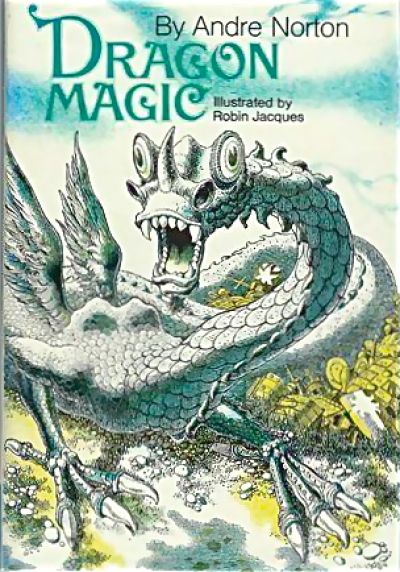The Fiftieth Norton in Fifty Weeks
Dragon Magic (Magic, volume 4)
By Andre Norton

23 Oct, 2015
0 comments
Andre Norton’s 1971 Dragon Magic is apparently the fourth book in Norton’s Magic series. Until now I had never even known the series existed, and certainly had not read any of the books in it.
The only things that Sig Dortmund, Artie Jones, Kim Stevens, and George Brown (or as he prefers to be called, Ras) all have in common are that they are all American boys and they all take the same school bus. Even that is not by itself enough to bring them together. While Artie and Sig are friends of a sort (Artie would far rather be friends with football hero Greg Ross, but he’s stuck with Sig), disinterest in bridging racial differences keeps them from reaching out to African-American Ras or Chinese-American Kim Stevens.
And then comes the treasure.…
An elderly man has recently passed away; his empty home is rumoured to be full of treasure. Artie and Sig break in and search the place. They don’t find gold or jewellery or bundles of money.
What Sig does find (and tries, unsuccessfully — and rather ominously given what is to follow — to keep secret) is a weird jigsaw puzzle. He feels an odd compulsion to try his hand at assembling it, Strangeness ensues. Sig finds himself reliving the events leading up to Sigurd’s slaying of the dragon Fafnir, as recounted in the Völsunga Saga. Oddly enough, he experiences them not as the heroic Sigurd, but as Sig Clawhand, a minor character never mentioned in the saga. He learns that love of treasure transformed the dwarf Fafnir into the dragon.
Sig tries to keep the puzzle secret, but fails. One by one, each of the other three boys comes into possession of the puzzle. One by one, each of the other three boys has a vision in which he experiences legendary events from the perspective of a minor character never mentioned in the original stories. The stories vary, but in each case, the boy dreams of someone who could, possibly, have been a real-life ancestor … and all of the visions involve dragons:
Ras experiences an episode in the life of Prince Sherkarer. A descendant of Pharaoh Piankhay of the now vanquished 25th Dynasty, Sherkarer was captured and enslaved by raiders from the north after the fall of Napata. Ultimately Sherkarer ends up in Babylon as the caretaker of the mysterious lau, a dragon-like animal from Africa. He befriends another outside, the Jew Daniel, and helps him humble his Babylonian overlords.
Artie experiences events in the life of a young Briton named Artos. Post-Roman Britain faces many dangers but thanks to the alliance under the High King Pendragon, thus far Britain has managed to withstand all of them. Now, thanks to the treachery of Modred, all that will come to an end.
Kim dreams that he is Mu-Ti, a young Chinese man who has the misfortune to live in the chaotic era later romanticized in the Romance of the Three Kingdoms. Through Mu-Ti’s eyes, Kim sees the events leading up to the resignation of First Minister Chuko Liang.
~oOo~
This is very nearly not a novel — its ending is certainly not really a resolution — but a collection of stories with a framing sequence.
Early on, I thought that this was going to be Norton’s novel about forced school busing … but it’s not mandated school integration that brings the boys together on the same bus. Their district has so few schoolchildren that everyone has to ride the same bus.
Although this isn’t about busing, this is a very 1970s young adult novel in many ways, from the carefully integrated group1, to the way they learn to overcome their differences and to the … hrm … I am going to go with “the earnest but dated portrayal of Angry Black Young Man Ras, torn between his conformist but hardworking parents and his firebrand older brother, whose anger and passion fascinate Ras, but who will almost certainly die in a hail of gunfire from police/FBI/COINTELPRO agents.”
Norton takes a page from Lucy Sussex (who is name-checked in the novel) by imagining historical events that might have led to familiar legends (although Sig’s story doesn’t quite fit; his story features actual magic and an actual dragon that isn’t either symbolic or a misunderstood beast). Aside from Sig’s vision, these are mundane takes on mythical events. I am sure I would have loved when I was a kid; I read my copy of The Lantern Bearers over and over again, after all.
Although I am not keen on Norton’s take on Ras, I will give her this: I cannot recall another young adult novelist who ever acknowledged Egypt’s 25th Dynasty or mentioned Piankhay by name. Norton’s interest in the Nubian dynasties in Egypt and Meroe inspired her to write at least one more novel drawing on that history, 1976’s Wraiths of Time.
Dragon Magic manages to be both atypical and characteristic of Norton’s novels. The stock 1970s juvenile structure isn’t much like her other books. The fact that she’s interested in and acknowledges African and Chinese history isn’t that surprising given the interests she demonstrated earlier in her career. This book was a bit of a curate’s egg, but it was definitely an interesting book on which to end this series of reviews.
1: Of boys, which by this time is somewhat unusual for Norton’s books. I wonder if later books in the series had girl protagonists?
